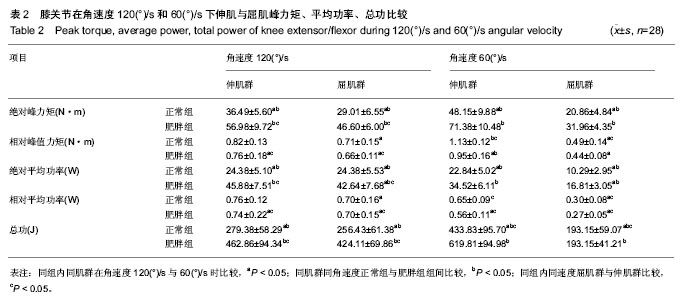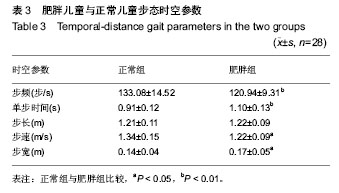| [1] 教育部.关于2010年全国学生体质与健康调研结果公告[EB].教体艺[2011] 4号.[2] Must A, Strauss RS.Risks and consequences of childhood and adolescent obesity.Int J Obes Relat Metab Disord. 1999; 23 Suppl 2:S2-11.[3] Pi-Sunyer X.Pi-Sunyer X.Postgrad Med.2009;121(6):21-33.[4] 徐轶群,季成叶,马军,等.超重肥胖对青少年健康相关生活质量的影响[J].中国学校卫生,2008, 29(3):211-212.[5] 许玲,陈晓红,陶芳标.肥胖对儿童生理功能的影响[J].实用预防医学,2005, 12(1):214-216.[6] Wren TA, Engsberg JR.Normalizing lower extremity strength data for children, adolescents, and young adults with cerebral palsy.J Appl Biomech. 2009;25(3):195-202.[7] Riddiford-Harland DL, Steele JR, Storlien LH. Does obesity influence foot structure in prepubescent children?Int J Obes Relat Metab Disord. 2000;24(5):541-544.[8] Abdelmoula A, Martin V, Bouchant A, et al. Knee extension strength in obese and nonobese male adolescents.Appl Physiol Nutr Metab. 2012;37(2):269-275.[9] Capodaglio P, Vismara L, Menegoni F, et al. Strength characterization of knee flexor and extensor muscles in Prader-Willi and obese patients.BMC Musculoskelet Disord. 2009;10:47.[10] Maffiuletti NA, Jubeau M, Agosti F, et al.Quadriceps muscle function characteristics in severely obese and nonobese adolescents.Eur J Appl Physiol. 2008;103(4): 481-484. [11] Rolland Y, Lauwers-Cances V, Pahor M, et al. Muscle strength in obese elderly women: effect of recreational physical activity in a cross-sectional study.Am J Clin Nutr. 2004;79(4):552-557.[12] Koster A, Visser M, Simonsick EM, et al. Association between fitness and changes in body composition and muscle strength. J Am Geriatr Soc. 2010;58(2):219-226. [13] 吴毅,占飞.等速肌力测试和训练技术在运动医学中的应用[J].中国运动医学杂志, 2002, 21(1):81-84.[14] Trost SG, Kerr LM, Ward DS, et al. Physical activity and determinants of physical activity in obese and non-obese children.Int J Obes Relat Metab Disord. 2001;25(6):822- 829.[15] 吕书红.儿童肥胖流行趋势及干预对策探讨[J].中国健康教育, 2002,18(8):526-528.[16] Hopkins ND, Stratton G, Tinken TM, et al. Relationships between measures of fitness, physical activity, body composition and vascular function in children.Atherosclerosis. 2009;204(1):244-249. [17] 窦祖林,南登昆.徒手肌力检查与定量肌力检查相关性初探[J]. 中国康复医学杂志,1992,7(3):109-111.[18] Tsiros MD, Coates AM, Howe PR, et al. Knee extensor strength differences in obese and healthy-weight 10-to 13-year-olds.Eur J Appl Physiol. 2013;113(6):1415-1422. [19] 陈琪.上肢徒手肌力测定与手握测力计测定的关系[J].国外医学:物理医学与康复学分册,1993,13(4):30.[20] 胡永善.膝伸屈等速肌力测试的可靠性研究[J].国外医学:物理医学与康复学分册,1997,17(3):112-113.[21] 倪国新.等速肌力测试的可靠性及相关因素[J].中国运动医学杂志,1999,18(4):355-357.[22] 罗安民,李珺晖,洪平.中国女子篮球运动员膝关节等速肌力测试分析[J].中国运动医学杂志,2012,31(6):517-522.[23] 张庆来.我国优秀青少年女了跳高运动员膝关节等速特征研 究[J].山东体育学院学报,2007;23(2):67-70.[24] 李涛,卢起.某省优秀男子水球运动员上肢等速肌力特征分析[J].按摩与康复医学(下旬刊), 2011,2(5):16-17.[25] 郭黎,陈文鹤,苑廷刚.优秀击剑运动员下肢三关节等速肌力测试分析[J].中国运动医学杂志,2010,29(2):163-166,169.[26] 贾富池,胡晓彦,崔巴特尔,等.髋关节屈伸肌力等速测试:体育学院大学生的特点[J].中国组织工程研究与临床康复,2010,14(11): 1975-1978.[27] 张瑞存,程丽彩,陈玉娟,等.跳跃项目训练对青少年膝关节屈伸肌肉力量的影响[J].中国组织工程研究与临床康复,2009,13(46): 9117-9120.[28] 陈一,郑洁皎,许怀宏,等.Biodex等速系统测试老年人膝关节屈伸肌力可靠性的初步研究[J].老年医学与保健,2009,15(1): 48-51.[29] 荣湘江,尤桂杰,姚鸿恩.不同运动水平大学生躯干屈伸肌群等速肌力和耐力测定[J].中国组织工程研究与临床康复,2008,12(2): 302-306.[30] 吴翊馨,张海平.应用等速测力系统分析足球运动员髋、膝关节屈伸等速向心工作的生物力学特征[J].中国组织工程研究与临床康复,2007,11(5):886-888,892.[31] 苑玲伟,周越,安莉.短跑运动员肩关节等速力景的测定与分析[J].中国组织工程研究与临床康复, 2007,30(5):897-899.[32] Browning RC, Kram R.Effects of obesity on the biomechanics of walking at different speeds.Med Sci Sports Exerc. 2007; 39(9):1632-1641.[33] 陆明,邱贵兴,赵丽娟.等速技术应用研究及进展[J].中华外科杂志, 2006,44(20):1437-1438.[34] 郁可,范建中.等速测试在我国康复医学中应用的现状和趋势[J].中国康复,2004,19(5):309-310.[35] 张庆来,戴瑞美,孟站领.普通小学生膝关节等速屈伸肌力测试分析[J].中国运动医学杂志,2005,24(6):705-706,711.[36] 翟凤鸣,李立,崔巴特尔,等.健康儿童膝关节屈伸工作时的生物力学规律[J].中国组织工程研究与临床康复,2008,12(42):8259- 8262.[37] 师玉涛,赵焕彬,王海涛.健康儿童膝关节屈伸肌力的等速测试研究[J]. 体育科研,2003, 24(6):46-48.[38] Abdelmoula A, Martin V, Bouchant A, et al. Knee extension strength in obese and nonobese male adolescents.Appl Physiol Nutr Metab. 2012;37(2):269-275.[39] Blimkie CJ, Sale DG, Bar-Or O.Voluntary strength, evoked twitch contractile properties and motor unit activation of knee extensors in obese and non-obese adolescent males.Eur J Appl Physiol Occup Physiol. 1990;61(3-4):313-318.[40] De Ste Croix M, Deighan M, Armstrong N.Assessment and interpretation of isokinetic muscle strength during growth and maturation.Sports Med. 2003;33(10):727-743.[41] Wren TA, Engsberg JR. Normalizing lower-extremity strength data for children without disability using allometric scaling. Arch Phys Med Rehabil. 2007;88(11):1446-1451.[42] Jaric S.Muscle strength testing: use of normalisation for body size.Sports Med. 2002;32(10):615-631.[43] Markovic G, Jaric S.Movement performance and body size: the relationship for different groups of tests.Eur J Appl Physiol. 2004;92(1-2):139-149. [44] 李敏,李立,陈玉娟.青少年男子膝关节屈伸肌群自然发育规律的等速肌力测试研究[J]. 首都体育学院学报,2010,22(6):81-84.[45] 成鹏,毕霞,郎海涛,等.速度因素对躯干等速肌力测试影响的研究[J]. 中国康复医学杂志,2004,19(8):578-580.[46] Schwartz MH, Rozumalski A, Trost JP.The effect of walking speed on the gait of typically developing children.J Biomech. 2008;41(8):1639-1650.[47] Daniels SR.The consequences of childhood overweight and obesity.Future Child. 2006;16(1):47-67.[48] Hills AP, Parker AW. Locomotor characteristics of obese children.Child Care Health Dev. 1992;18(1):29-34.[49] McMillan AG, Pulver AM, Collier DN, et al. Sagittal and frontal plane joint mechanics throughout the stance phase of walking in adolescents who are obese.Gait Posture. 2010;32(2): 263-268.[50] Hills AP, Parker AW. Locomotor characteristics of obese children.Child Care Health Dev.1992;18(1):29-34.[51] Nantel J, Brochu M, Prince F. Locomotor strategies in obese and non-obese children.Obesity (Silver Spring). 2006;14(10): 1789-1794.[52] Nantel J, Mathieu ME, Prince F. Physical activity and obesity: biomechanical and physiological key concepts.J Obes. 2011; 2011:650230.[53] Krebs NF, Himes JH, Jacobson D, et al. Assessment of child and adolescent overweight and obesity.Pediatrics. 2007;120 Suppl 4:S193-228.[54] D'Hondt E, Deforche B, De Bourdeaudhuij I, et al. Postural balance under normal and altered sensory conditions in normal-weight and overweight children.Clin Biomech (Bristol, Avon). 2011;26(1):84-89. [55] Raynor AJ. Strength, power, and coactivation in children with developmental coordination disorder.Dev Med Child Neurol. 2001;43(10):676-684.[56] Eek MN, Tranberg R, Zügner R, et al.Muscle strength training to improve gait function in children with cerebral palsy.Dev Med Child Neurol. 2008;50(10):759-764.[57] 成鹏,毕霞,杨红.膝关节等速测试峰力矩与总功及平均功率的相关分析[J].中国康复,2000,15(2):73-74.[58] Shultz SP, Anner J, Hills AP. Paediatric obesity, physical activity and the musculoskeletal system.Obes Rev. 2009; 10(5):576-582.[59] McMillan AG, Pulver AM, Collier DN, et al. Sagittal and frontal plane joint mechanics throughout the stance phase of walking in adolescents who are obese.Gait Posture. 2010;32(2): 263-268. [60] DeVita P, Hortobágyi T.Obesity is not associated with increased knee joint torque and power during level walking.J Biomech. 2003;36(9):1355-1362.[61] 曹峰锐,邹亮畴,彭森.女子曲棍球运动员膝关节屈伸肌群等速测试与分析[J].中国组织工程研究与临床康复,2011, 15(37): 6891-6894.[62] Shultz SP, Hills AP, Sitler MR,et al. Body size and walking cadence affect lower extremity joint power in children's gait.Gait Posture. 2010;32(2):248-252.[63] Browning RC, McGowan CP, Kram R.Obesity does not increase external mechanical work per kilogram body mass during walking.J Biomech.2009;42(14):2273-2278. [64] Samson W, Desroches G, Cheze L, et al. 3D joint dynamics analysis of healthy children's gait.J Biomech. 2009;42(15): 2447-2453. |


.jpg)
.jpg)